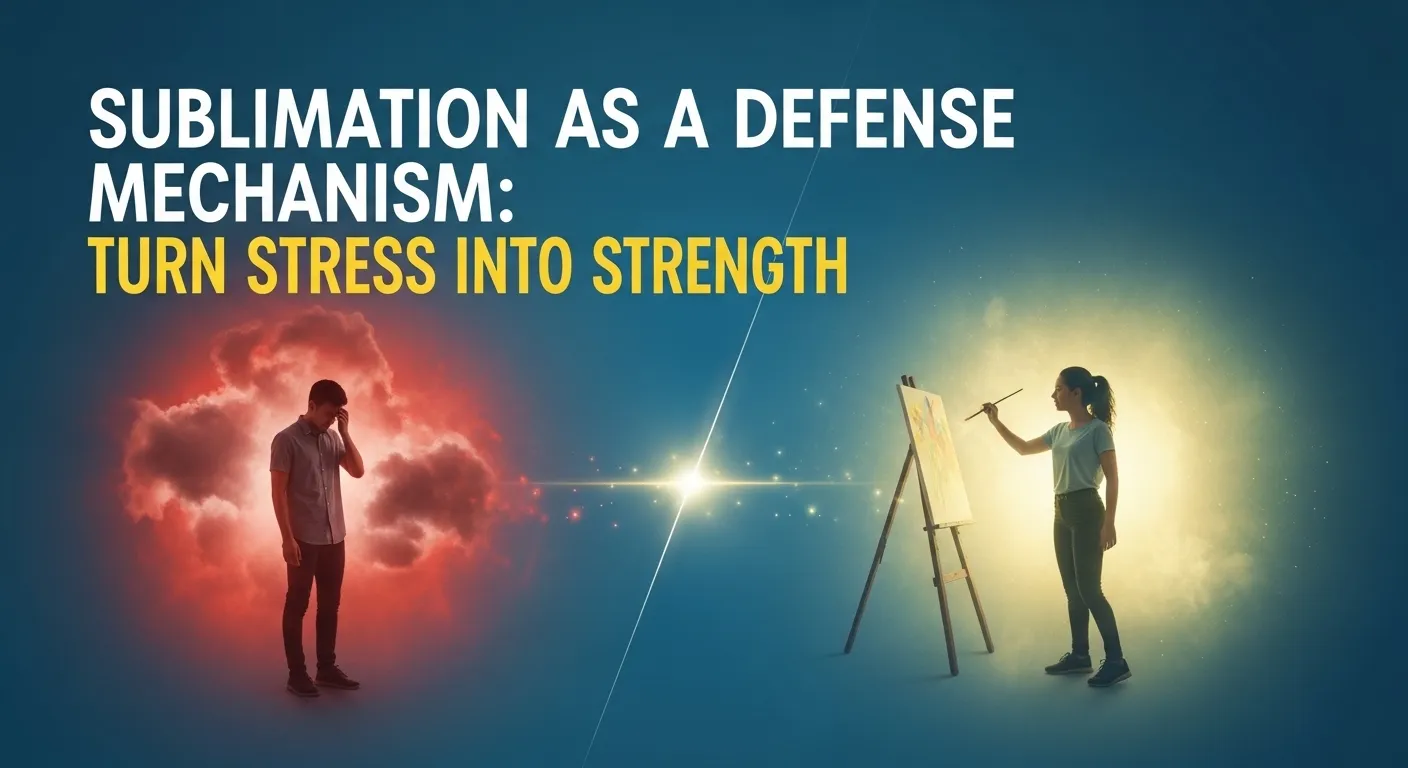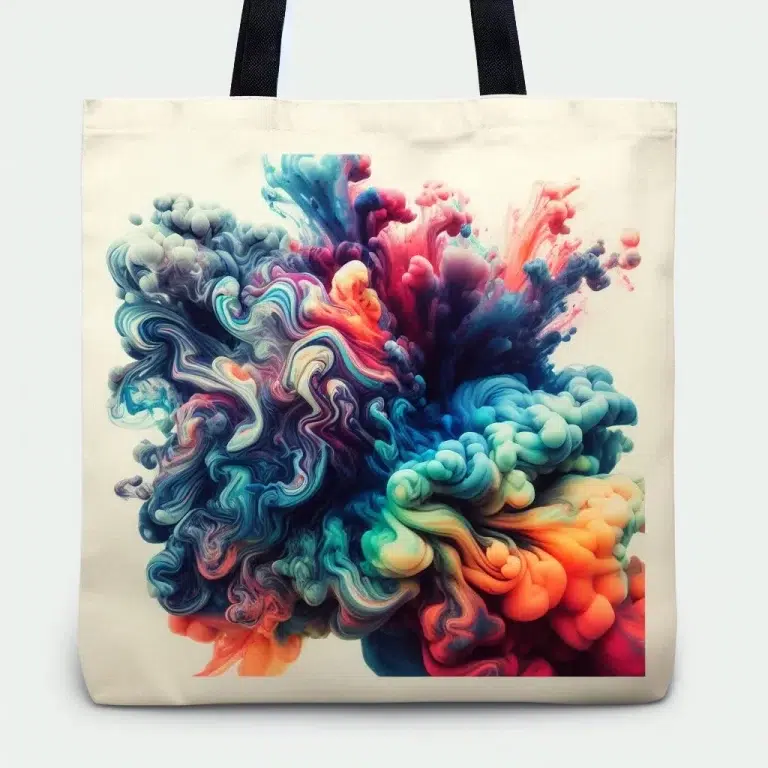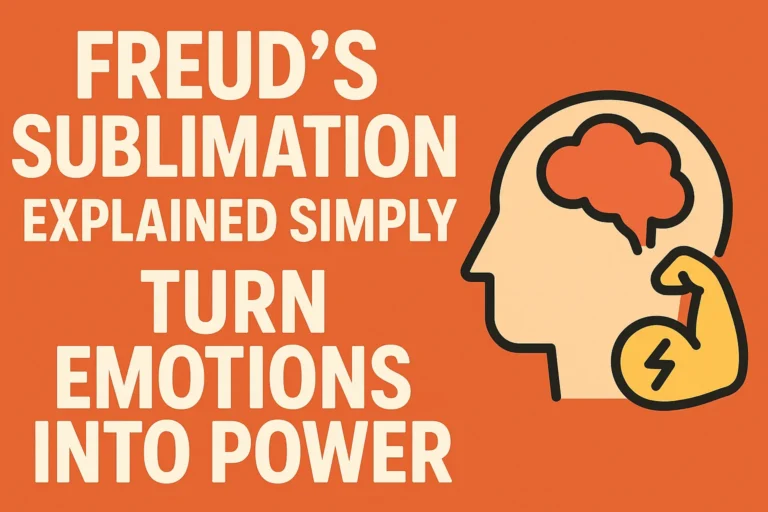Sublimation as a Defense Mechanism: Turn Stress into Strength
Sublimation as a defense mechanism means turning unwanted emotions into positive actions. Instead of acting on anger or frustration, a person channels those feelings into art, work, or fitness. It’s a healthy coping strategy in psychology that transforms negative energy into creative or productive behavior, promoting emotional growth and balance.
Sublimation helps you transform emotional tension into purpose, turning what weighs you down into something that lifts you up.
We all deal with emotions that feel too heavy or hard to express. Sublimation as a defense mechanism is the healthy way to handle them, it’s when you turn strong or negative feelings into something positive or creative, like using anger to push harder at the gym or sadness to inspire art.
It matters because sublimation helps you:
- Channel emotions instead of suppressing them
- Reduce stress in a healthy way
- Grow more self-aware and balanced
If you want to dig deeper into how sublimation shapes our thoughts and behaviors, check out Sublimation in Psychology it breaks down the science behind this defense mechanism in a simple
Origins & Theoretical Background
Understanding where sublimation came from helps make sense of why psychologists still talk about it today. The idea traces back to Sigmund Freud, the father of psychoanalysis, and has evolved into a modern view of emotional maturity and self-regulation.
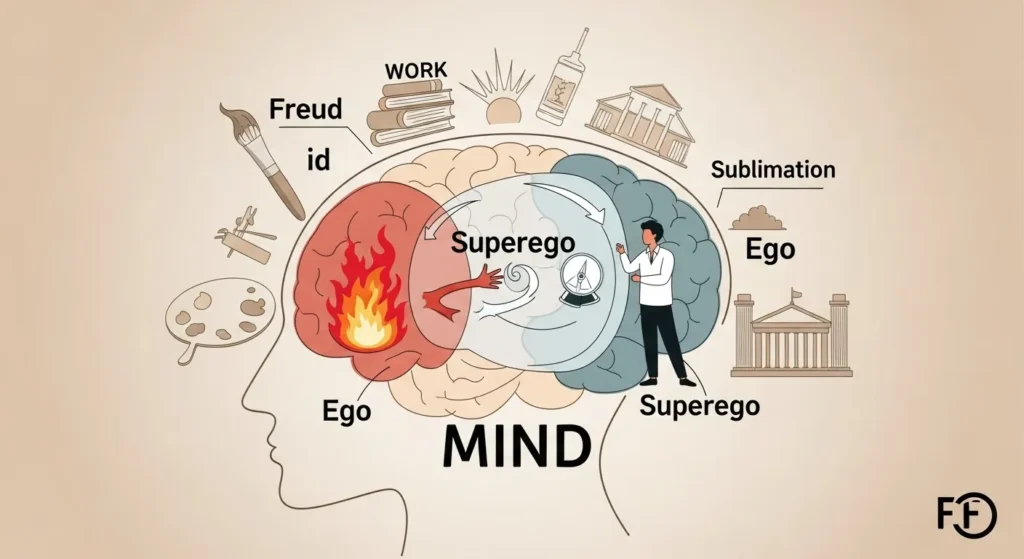
Freud and Psychoanalytic Roots
Freud believed the human mind has three main parts, the id, ego, and superego.
- The id wants instant satisfaction (our raw impulses).
- The superego acts like a moral compass, shaping our sense of right and wrong.
- The ego sits in the middle, finding ways to satisfy both without creating guilt or chaos.
Freud saw sublimation as one of the healthiest ways the ego manages conflict between these forces. Instead of repressing impulses, sublimation redirects them into socially acceptable outlets. For example, someone with aggressive drives might channel that energy into competitive sports, leadership, or art.
He called sublimation a mark of civilization and maturity, a way for humans to transform instinctive urges into creativity, work, or culture itself.
(Sources: Wikipedia, Simply Psychology)
Evolution of the Concept & Modern Psychology
Modern psychology has built on Freud’s idea, focusing less on unconscious urges and more on emotional regulation and adaptive coping. Today, sublimation is seen as a mature defense mechanism that helps people turn inner tension into purposeful action.
Researchers describe it as a bridge between emotional control and personal growth, it’s not just about suppressing impulses but reframing them into productive motivation.
Psychologists now group defense mechanisms into levels:
- Mature (sublimation, altruism)
- Neurotic (displacement, repression)
- Immature (denial, projection)
Sublimation stands at the top of that list because it promotes both mental health and creativity.
Freud saw sublimation as turning instinct into art, society, or progress, and modern psychology agrees. It’s a natural skill that helps us channel emotion into growth instead of chaos.
How Sublimation Works
Sublimation turns raw feelings into useful action, by redirecting the energy behind the feeling into something socially okay and personally productive.
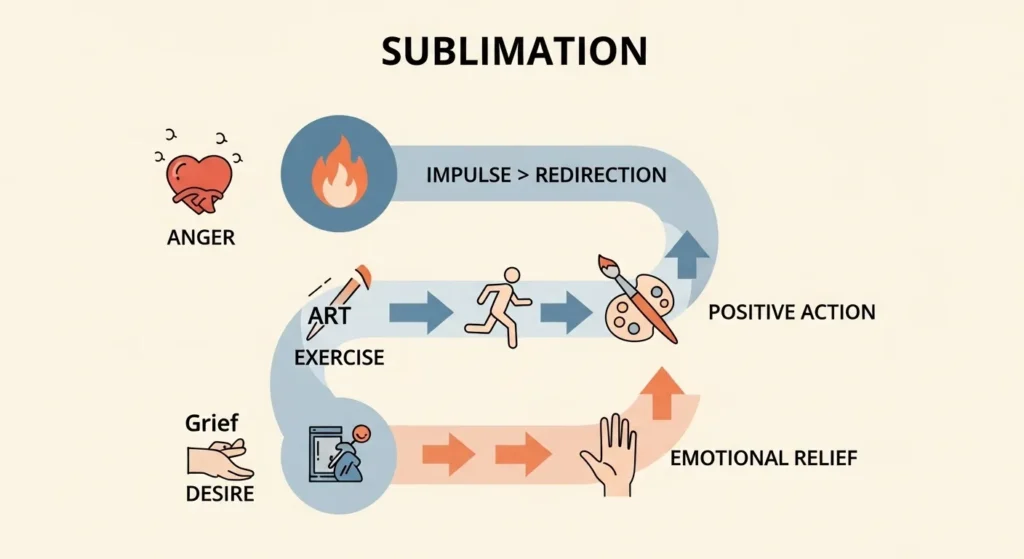
Step by step
- You feel an impulse, like anger, sexual tension, or grief.
- Instead of acting on it directly, your mind redirects that energy.
- The energy flows into a socially accepted outlet, like art, sports, work, or volunteering.
Example: frustration becomes intense workouts, or romantic longing becomes songwriting.
Conditions and triggers
- Shows up under stress, strong urges, or when an impulse feels unacceptable.
- Often appears when someone has skills or outlets available, like artistic talent or a gym habit.
- Can be conscious, like choosing to paint when upset, or mostly unconscious, where you just “throw yourself” into a project.
Why it’s healthy
- It’s adaptive, it reduces harm to self and others.
- It turns negative energy into creativity, achievement, or community benefit.
- Using sublimation builds self control and purpose, instead of burying feelings or acting out.
Quick action: Notice one strong feeling this week, pick a safe outlet (write, move, create), and see if the tension shifts. Want how sublimation affects emotional balance and coping patterns? Read Mental Health in Sublimation to see how it links creativity with emotional resilience.
Examples in Everyday Life
Sublimation isn’t about ignoring your emotions. It’s about giving them a purpose. When you channel intense feelings into something positive, you’re not escaping them, you’re mastering them.
1. Creative outlets (art, writing, music)
A painter uses heartbreak as fuel for a new art series, or a songwriter turns anxiety into lyrics. The impulse, pain or longing, gets transformed into creative expression. It helps release emotion while creating something meaningful for others.
2. Physical outlets (sports, exercise)
Someone with a lot of built-up anger takes up boxing, or a stressed student goes running to clear their head. The original impulse, aggression or frustration, gets redirected into physical energy and focus, not harm.
3. Career or professional outlets
A person with strong control or perfectionist tendencies becomes a surgeon or architect, where precision and discipline are valued. The impulse for dominance or control finds a productive home in a structured career path.
4. Community or volunteer outlets
Someone who once felt guilt or frustration about injustice starts mentoring teens or volunteering at shelters. The impulse, guilt, helplessness, or frustration, turns into compassion and service.
Sublimation vs Other Defense Mechanisms
It’s easy to confuse sublimation with other defense mechanisms since they all deal with redirecting emotions. The difference lies in where the energy goes and what outcome it creates.
All defense mechanisms protect you, but sublimation transforms. It’s not about escaping emotion, it’s about using it to create, connect, and evolve.
Here’s a quick comparison to make it clear:
| Defense Mechanism | What It Redirects or Transforms | Outcome | Simple Example |
|---|---|---|---|
| Sublimation | Turns unacceptable impulses (anger, desire, frustration) into positive or creative outlets | Constructive – builds growth, creativity, discipline | Channeling anger into painting or running |
| Displacement | Shifts emotion from the real target to a safer one | Less constructive – relieves tension but doesn’t solve root cause | Yelling at a sibling after being scolded by a boss |
| Reaction Formation | Acts opposite to true feelings to hide them | Defensive – masks emotion instead of processing it | Being overly nice to someone you secretly dislike |
| Rationalization | Reframes reality to justify behavior or feelings | Avoidant – protects ego but blocks honesty | Blaming “bad luck” for missing a deadline you procrastinated on |
| Altruism | Turns personal discomfort into acts that help others | Highly constructive – benefits both self and others | Volunteering to cope with guilt or loss |
Why these differences matter:
Understanding how these mechanisms work helps you see your emotional patterns clearly. If you often displace or rationalize, you’re managing stress but not resolving it. Sublimation and altruism, on the other hand, help you grow from emotion, not just hide it.
For real-world ways to apply these ideas, explore 7 Sublimation Psychology Hacks it’s packed with actionable ways to channel emotions into progress.
Limitations & When to Be Cautious
Sublimation’s often seen as one of the healthiest defense mechanisms, but it’s not a magic fix. Even when impulses are redirected in positive ways, the core emotions or conflicts behind them might still need attention.
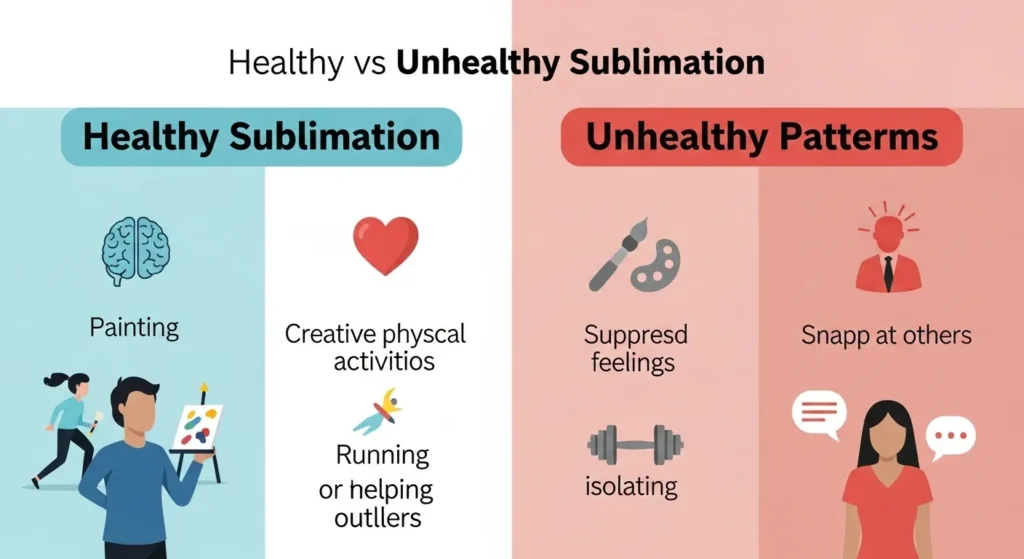
Here’s where it can get tricky:
- Over-reliance on one outlet – If someone uses work, art, or fitness as their only coping tool, it can become avoidance in disguise. For example, channeling anger into overworking might look productive but could be hiding burnout or resentment underneath.
- Emotional disconnection – Constant sublimation can dull self-awareness. You might forget why you’re so driven to create, perform, or achieve in the first place.
- False sense of resolution – Redirecting energy feels good, but if the root issue (like grief, guilt, or trauma) stays unaddressed, it might resurface later in other forms.
Restoration and Hope:
Recognizing these limits doesn’t make sublimation bad, it just means it works best when balanced with reflection and emotional honesty. Talking to a therapist or counselor can help uncover what’s fueling those impulses, so the coping stays healthy and growth-oriented.
To see the full picture, including what happens when sublimation doesn’t occur, check Opposite of Sublimation it explains contrasting defense mechanisms and their effects.
Practical Steps: How to Use Sublimation in Your Life
Sublimation’s all about turning raw emotion into something meaningful. Here’s how you can start using it in a simple, real-world way.
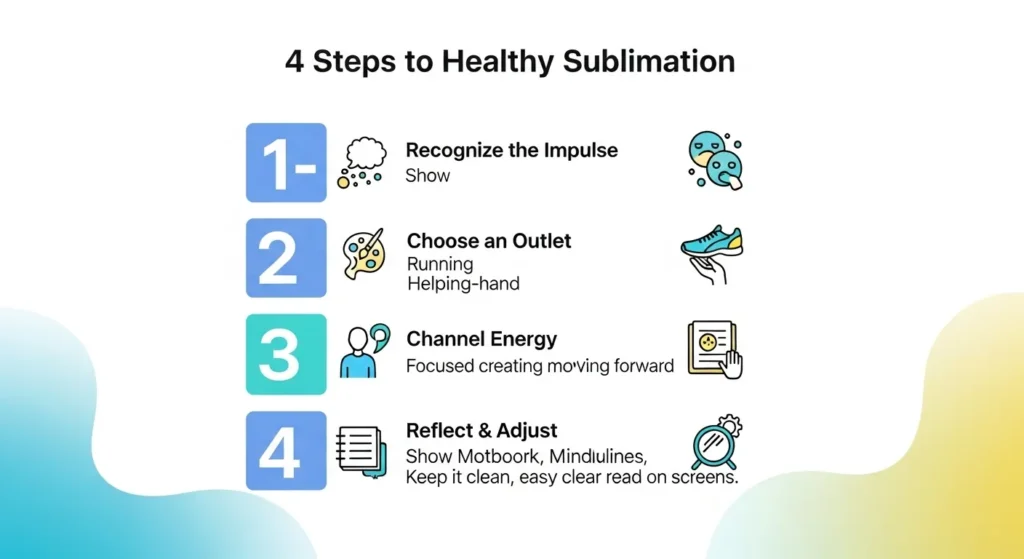
Step 1: Recognize the Impulse
Pause and name what you’re feeling, anger, sadness, jealousy, guilt, or even desire. Awareness is the first move.
Example: “I’m furious after that argument.”
Step 2: Choose an Outlet
Pick something that fits your emotion and values.
- Creative: paint, write, play music
- Physical: run, dance, clean, do sports
- Service-oriented: volunteer, mentor, help others
Example: Instead of lashing out, you spend an hour sketching or cleaning up your workspace.
Step 3: Channel Energy Consciously
Don’t just distract yourself, direct yourself. Set a goal like “I’ll write for 30 minutes to express this feeling.” Intentional redirection builds control instead of avoidance.
Step 4: Reflect and Adjust
Afterward, check in: “Do I feel calmer, lighter, more in control?” If not, maybe another outlet or professional help—is worth exploring.
Quick Tips:
✅ Keep a “mood-to-action” list (what helps when you feel certain ways)
✅ Balance activity with reflection, don’t just stay busy
✅ Seek therapy if your impulses feel overwhelming or repetitive
When to Seek Help:
If emotions feel too strong, or your outlets stop working, a licensed therapist can help unpack what’s behind the impulse so you’re not just managing but healing.
Mind Rechannel Map: How Emotions Transform Through Sublimation
Sublimation is basically emotional alchemy, turning something raw into something refined.

When you start noticing your impulses, you can redirect them toward something that actually helps you grow. Here’s what that looks like:
| Emotion / Impulse | Inner Drive | Healthy Outlet | Positive Result |
|---|---|---|---|
| Anger | Control, power | Boxing, running, debate | Energy release, focus |
| Guilt | Responsibility | Volunteering, mentoring | Emotional repair, self-worth |
| Desire | Passion, curiosity | Art, design, learning | Creativity, connection |
| Frustration | Growth need | Problem-solving, building | Achievement, pride |
Try this: Next time you feel a strong emotion, pause and ask “What’s the productive version of this feeling?”
How people cope with stress, 2025 (survey highlights)
Percent of respondents using each coping method. Data shown as horizontal bars for quick comparison.
Mini insight: A purposeful outlet usually gives more relief. It’s about transforming emotion, not avoiding it.
Expert Tip: Turning Inner Tension into Growth Energy
🧠 Expert Insight: “Sublimation isn’t suppression, it’s smart redirection. You’re taking emotional fuel and using it to power something that matters.”
When you feel an inner conflict, instead of ignoring it, use it as creative momentum. Artists, entrepreneurs, even athletes often channel emotional intensity into results. That’s sublimation in action.

Pro Tip: Next time you’re overwhelmed, grab a journal and write down what that emotion wants. Then brainstorm one constructive way to use it.
Self-Check: Are You Practicing Healthy Sublimation?
Here’s a quick self-assessment checklist to see if you’re using sublimation positively:
✅ I turn frustration into something creative or productive
✅ I use exercise or art to process stress
✅ I notice what triggers me before reacting
✅ I feel proud after expressing emotions in healthy ways
✅ I don’t rely on one outlet too much
If you said “yes” to 3 or more, you’re likely using sublimation as a mature coping strategy.
If not, it’s okay, awareness is step one. You can always learn new outlets and adjust your habits.
Before & After: Real-World Scenarios of Sublimation in Action
You can’t stop feelings, but you can change their destination. That’s where real emotional strength begins.
See how sublimation changes reactions from impulsive to intentional:
| Situation | Before (Unchanneled Emotion) | After (Sublimated Action) |
|---|---|---|
| Anger at boss | Complaining, snapping | Channeling energy into a side project |
| Jealousy | Negative thoughts | Using motivation to improve skills |
| Stress from failure | Avoiding tasks | Creating a new plan or exercise routine |
| Guilt | Self-blame | Volunteering or helping someone else |
